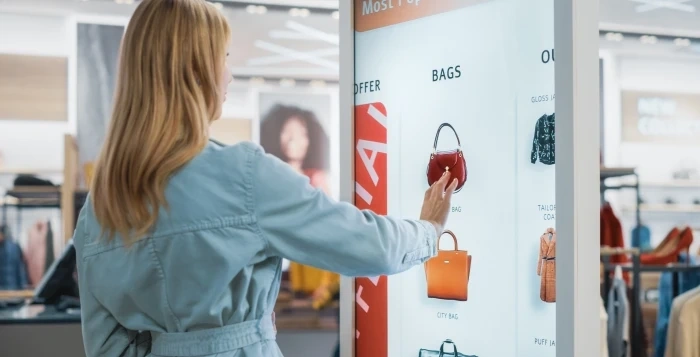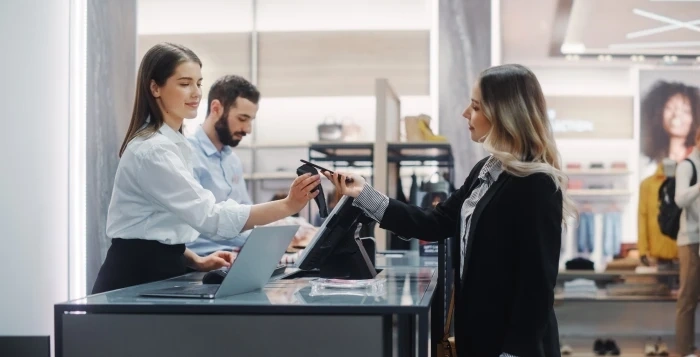The retail industry has witnessed a technology-fueled disruption driven by consumer demands, a shifting market landscape and intensified competition in recent years. While the transformation opens up immense opportunities to improve the bottom line, it brings several challenges in managing legacy systems, workforce alignment and customer expectations. As customers seek personalized and assisted shopping journeys, seamless and omnichannel consumer experiences play a pivotal role in retail success. These experiences require retailers to adapt robust solutions, processes and systems that transform customer touchpoints. Cloud and AI-powered solutions can equip retailers to deliver seamless, hyper-personalized customer journeys, unlocking next-gen retail capabilities for experience-driven commerce.
Evolution of retail value-chain – evaluating the impact
Over the past few decades, retail has evolved from small neighborhood shops to expansive mega stores and entertainment-filled malls. While the initial stages focused on supplying products, with the permeation of technology and shifting marketing paradigms, retailers realized the importance of offering immersive customer experiences to stay competitive. The changed imperative gave rise to modern retail chains that have transformed shopping areas into vibrant experience centers featuring cafes, entertainment zones and personalized services, fostering customer loyalty and engagement. The COVID pandemic disrupted this customer-centric retail model as social distancing and safety concerns reshaped shopping behavior and pushed consumers towards online channels. In 2020, over 80% of consumers across the globe shopped online.
Forced by the crisis, retailers accelerated digital transformation efforts. The transformation included contactless technologies like cashless payments, self-checkouts and digital engagement models like QR codes and digital in-store events. (live commerce and quick-commerce) The growth in this period was primarily driven by convenience and necessity. However, as the initial phase of panic buying subsided, gaps in the online-only model emerged. Over 60% of surveyed consumers missed the personalized guidance from in-store sales associates. Product returns and exchanges became tedious without physical access. Customers missed the touch-and-feel evaluation and social aspects of shopping with friends and family. Curbside pickups and buy online & pick in-store (BOPIS) models helped but could not adequately recreate the store experience.
These factors underscored that online shopping, despite its meteoric rise, could not replace physical stores. As consumers craved the tangible aspects of shopping, retailers were required to revive their physical footprint by enhancing the store experience. However, simply reopening the store was insufficient as modern consumers of the millennial and Gen-Z era expected ultra-convenience and personalization consistently across stores and online.
The future of retail
The current industry outlook indicates that the future of retail is manifesting as "Phygital" - harmonious convergence of physical and digital platforms. Global retail flagships are pioneering integrated omnichannel ecosystems that unify inventory, orders, and customer data processes to enable consistent experiences across online and brick-and-mortar touchpoints. Strategic retail blueprints increasingly emphasize breaking channel silos. For instance, with its interactive format, Nike's 'Live' concept store merges digital innovations like predictive recommendations and contactless payments for an engaging in-store flagship experience.
Operational optimization through automation technologies is another pivotal priority. Retail giants are investing in AI-powered computer vision solutions like autonomous store drones that can scan shelves and detect out-of-stock gaps in real-time. By auto-generating such inventory insights, associates can switch focus to customer-centric activities. For instance, Walmart deploys intelligent robotic automation in warehouses to handle the exponential surge in online orders, enhancing warehouse efficiency and reducing manual efforts.
Modern consumer behavior is driven by personalization and customization, leading to retailers implementing IoT sensors and camera feeds to gather shopper data and then leveraging AI to determine buying patterns and curate tailored product recommendations. For instance, Sephora's virtual try-on solution scans lip contours to suggest bespoke lip colors based on customers' unique lip shapes, demonstrating the scope of hyper-personalization powered by emerging technologies.
Immersive technologies like AR and VR are entering retail environments in innovative avatars to redefine engagement. Solutions like Dior's VR mirror, enabling shoppers to sample different products visually, bring experiential commerce to life. Equally notable are interface devices like motion-activated smart retail shelves that deliver contextual and real-time content aligned to surrounding spatial data and shopper proximity. As phygital ecosystems emerge, the possibilities for enriching consumers' lifestyle experiences remain a compelling narrative for modern retail growth.
Retail Workplace as a service paves the way forward

Retail workplace-as-a-service enables retailers to transform stores and digital channels with interactive and personalized shopping experiences. Spanning end-to-end processes, it equips retailers with intelligent capabilities for understanding customers, empowering staff and optimizing store environments for success.
In-store experience
Retailers can dynamically display personalized pricing, product availability and recommendations by seamlessly integrating Electronic Shelf Labels (ESLs) and in-store digital signage with real-time inventory and promotions data feeds. This provides tailored guidance, enhancing buying confidence and satisfaction.
Interactive self-service kiosks and POS
Sleek interactive kiosks powered by AI-based recommendations help shoppers explore and discover relevant products, guiding them through the purchase journey. Kiosks offer wayfinding assistance across large, multi-level store layouts. Self-service POS with mobile integration enables expedited checkout to manage peak store traffic.
Experience mapping with AI cameras
Powerful AI Video Analytics models track shoppers' trajectories and behavior within the store area to discern movement patterns and dwelling hotspots. These insights feed into experiment-driven layout planning, inventory stocking and staffing recommendations optimized for maximizing store conversions.
Omni-channel user experience management
A unified customer data dashboard offers complete visibility into buying preferences and behavior across interaction channels. Retailers can serve hyper-personalized recommendations and connectivity to virtual shopping assistants. Omni-channel support with live chat and click-to-call enable instant query resolution.
Frontline workforce management
Retailers can drive higher team productivity in serving customer needs by equipping store associates with mobile apps encompassing inventory status, order taking and fulfillment workflows. Automated workforce management and collaboration tools simplify scheduling and communication.
Retail workplace-as-a-service guides retailers to phase their transformation journey with unified retail experiences via continuous AI-based recommendations and optimization.
Delivering value for enterprises and customers
Retail Workplace as a Service empowers retailers to drive growth through cutting-edge capabilities. The key benefits include:
Increased sales and conversion
Personalized promotions and tailored product recommendations powered by AI increase basket sizes and conversion rates. Strategic recommendations boost upselling opportunities.
Improved customer experiences
Smart self-service options, combined with customized assistance, enable consistent, seamless shopper journeys - building loyalty and satisfaction.
Reduced costs
Advanced analytics provide data-driven insights into optimizing labor scheduling, inventory management and layouts - balancing costs and strategic imperatives.
Higher employee productivity
Integrating workflow automation and mobile tools removes routine tasks - allowing staff to deliver best-in-class customer support instead.
Competitive advantage
Data-driven insights on emerging consumer preferences empower retailers to continually adapt their offerings, stores and experiences ahead of the competition.

Driving productivity and elevating experiences for retail organizations
As consumer behaviors and expectations around retail continue to evolve at a rapid pace, retailers must lead the charge in transforming shopping experiences rather than reacting to ongoing disruptions. Implementing robust innovations across all facets of retail is imperative to thrive amid intensifying competition. Retail Workplace as a Service empowers retailers with an integrated suite of next-generation capabilities to drive measurable improvements. From personalized promotions powered by AI to advanced analytics providing data-driven insights to seamless self-service options complemented by customized assistance, the solution consolidates cutting-edge innovations into a single unified experience, allowing retailers to boost revenue, achieve operational efficiencies, deliver superior customer journeys and maximize employee productivity.



